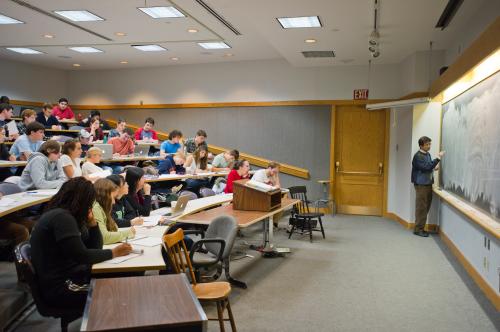The largest expansion of college aid for military veterans in a decade, the Harry W. Colmery Veterans Educational Assistance Act of 2017, is poised to become the newest update to the GI Bill. The core mission of the GI Bill since its creation in 1944 is to support veterans and their families through education. While this mission remains constant, the specific policies implemented through six iterations of the GI Bill have changed over time. These changes often reflect broader concerns about national security and the American economy, and the newest iteration of the bill is no exception.
Today, Americans may be most familiar with one of the core components of the GI Bill: It provides 100 percent of in-state tuition for veterans and their families. The bill that the House recently passed unanimously, coined the “Forever” GI Bill, maintains this provision while making several important changes, including eliminating the 15-year expiration date of education benefits and providing additional payment for veterans studying the STEM fields. These legislative updates simultaneously support veterans and their families as well as aim to reduce the skills gap in the U.S. workforce.
Serving veterans’ and national interests over time
Introduced as the Servicemen’s Readjustment Act of 1944, the original GI Bill promised to ease WWII veterans’ transition into the civilian workforce. Although the bill provided job counseling, stipends, and unemployment benefits for soldiers, the country faced a potential problem: Millions of soldiers directly entering the job market after the war would overwhelm the American workforce and leave many veterans unemployed. To avoid this, the bill offered $500 per year for veterans to begin or resume education/technical training upon their return home. Rather than inundating the job market, veterans flooded institutions of higher education, forcing colleges to set up tents and barrack-like buildings to house the influx of students.
In 1947, veterans comprised 49 percent of college students in America. By 1956, 7.8 million veterans had gained training, certifications, and degrees, and research suggests that the GI Bill increased collegiate attainment for WWII veterans. The first GI Bill not only aided veterans in their transition back to civilian lives, but also eased the country’s transition to the post-war economy. Notably, however, the GI Bill was not a panacea for veteran education, exacerbating existing racial inequalities in higher education. Additional research suggests that the Vietnam-era GI bill is associated with more post-secondary education among veterans, although not with higher earnings.
Fast forward to the 21st century: The last major update to the GI Bill was in 2008, through the Post-9/11 Veterans Educational Assistance Act of 2008. Unlike previous versions of the bill, this iteration provided 100 percent of in-state tuition or the national maximum of funding allotted for private school tuition for eligible veterans serving on or after Sept. 11. Veterans were required to use this service within 15 years of their service completion date. The bill also expanded education benefits to veterans’ dependents. Veterans who had served at least six years in the military were able to transfer their GI Bill education benefits to their spouse if they agreed to serve for four more years. Veterans who had served at least 10 years were allowed to transfer the benefits to their children.
In the context of ongoing wars in Afghanistan and Iraq, some interpreted the 2008 bill as designed not only to provide education benefits to veterans, but also to incentivize Americans to enlist and to retain those already serving. Like the original bill, this version sought to support veterans and their families while simultaneously addressing current national priorities.
The ‘Forever’ GI Bill
The Forever GI Bill retains these incentives and, at the same time, acknowledges the demands of today’s economy. Several of the educational benefits offered to veterans in this bill seem directly aimed at not only supporting veterans, but at addressing a national concern: the skills gap.
Today’s workforce faces a dramatically different challenge than that of the Post-WWII era. Too few skilled workers are entering the workforce, and many jobs are unfilled. Among the many updates to the bill, two provisions in particular—the removal of the 15-year expiration date of education benefits and the emphasis on the STEM education—specifically address this need for more skilled workers through education.
By removing the 15-year cap on the use of educational benefits, the Forever GI Bill supports veterans entering the workforce at any point during their post-service career. Nearly 21 percent of veterans currently using the Post-9/11 GI Bill are 35 or older. Under this new legislation, veterans will have a greater opportunity to use their educational benefits later in their post-service career. By pursuing new training or updating their skills, veterans can remain competitive in the job market. At the same time, employers may benefit from an expanded pool of job applicants who have the required skills.
Along these lines, by increasing support for veterans studying science, technology, engineering, and math, the Forever GI Bill encourages veterans to gain technical skills that are currently in high demand. In 2018, there are projected to be 2.6 million STEM-related job openings in America. Currently, only 14 percent of veterans using the Post-9/11 GI Bill have gained certifications/degrees in STEM, and only 39 percent of those using the this bill have attended a 2-year program. Under the new bill, veterans studying STEM fields may be granted an extra year of funding for their education. By incentivizing entrance into the STEM fields, the new GI Bill builds on veterans’ strengths to increase the number of skilled STEM workers in the country. As House Majority Leader Kevin McCarthy (R-Calif.) said, “Veterans are prime candidates for tech positions because of their military discipline, ability to work under pressure, and teamwork.”
When he signed the first GI Bill in 1944, President Franklin D. Roosevelt noted that the bill “gives emphatic notice to the men and women in our armed forces that the American people do not intend to let them down.” Subsequent iterations of the bill have not only worked to fulfill this mission, but also reflect evolving demands on the nation’s armed forces, veterans, and the broader workforce. The Forever GI Bill continues this trend, providing benefits to veterans that are geared toward keeping the United States economically competitive by building a workforce that is better prepared to meet the needs of employers.
Caitlin Dermody contributed to this post.







Commentary
Transitioning from war to workforce under the new ‘Forever’ GI Bill
July 28, 2017